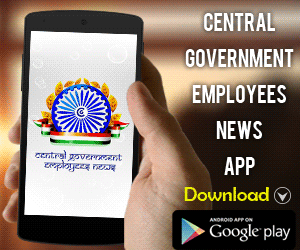Revision of Minimum Pay and Fitment formula due to increased revenue collections of the Central Government
Comrades,Today none of the 7th CPC related demands of Central Government Employees are settled. The assurance given by the Group of Ministers to the NJCA leaders regarding increase in Minimum Pay and Fitment formula is in paper even after a lapse of 20 months. Now the Finance Minister has replied in Parliament that "no change in Minimum Pay and Fitment formula is at present under consideration".
To avert the 11th July CG employees strike the Hon'ble Prime Minster had instructed the group of Hon'ble Ministers including Shri Rajnath Singhji, Hon'ble Home Minister, Shri Suresh Prabhuji , Hon'ble Railway Minister and Shri Arun Jaitelyji , Hon'ble Finance Minister to hold discussions with the Staff Side (JCM) on 30th June 2016 and the Shri Arun Jaitelyji , Hon'ble Finance Minister had published a written assurances in the Government website on 6th July 2016 leading to deferment of the strike .
Pay Commission Objective: It is the endeavour of every pay commission to ensure that the pay and allowances of employees should be ‘fair and reasonable'. The pay structure should also motivate the employees to reasonable levels of performance in the tasks assigned to them, so that the general public derive the benefit of their service as intended.
Our demand of revision of Minimum Pay and Fitment formula is quite justified.
Comparison
of earlier wage hike we can observe that the fitment factor of 2.57
times is the lowest comparing to other pay commissions. If we make a
study of earlier pay commission.| Pay Commission | Year | Minimum wage ( old ) | Minimum wage (revised) | Increase |
| 2nd CPC | 1959 | Rs 55/- | Rs 80/- | 1.45 times |
| 3rd CPC | 1973 | Rs 80/- | Rs 196/- | 2.45 times |
| 4th CPC | 1986 | Rs 196/- | Rs 750/- | 3.82 times |
| 5th CPC | 1996 | Rs 750/- | Rs 2550/- | 3.40 times |
| 6th CPC* | 2006 | Rs 2550/- | Rs 7000/- | 2.74 times |
| 7th CPC * | 2016 | Rs 7000/- | Rs 18000/- | 2.57 times |
Comparative picture of pay of Central Government and State Government in regards to minimum wage as on 1.7.2017
Many
of the State Governments are following the Central Government pay
scales, but a few state Governments have improved upon the Central
Government pay scales. The examples are as under:| Government Agency | Group "D" Basic pay in Rs | Add Skill 25% from Group "D" to Group "C" | Group "C" Basic Pay in Rs | DA% | Add DA Amount in Rs | Basic Pay in Group "C" in Rs |
| Govt. of India | Nil | 18000 | 5 | 900 | 18900 | |
| AndhraPradesh & Telangana | 13000 | 3250 | 16250 | 24.1 | 3916 | 20166 |
| Kerala | 16500 | 4125 | 20625 | 14 | 2887 | 23512 |
| Karnataka | 17000 | 4250 | 21250 | Nil | 21250 |
The financial position of the Central Government is very good. Even the GDP (Gross Domestic Product) has shown increase in last few years which is around 7% , the Indian economy is fastest growing and placed 7th in the world ( which is at 2,250.987 billions of $ ), comparing to wages paid in the world our wages are at lower level. The Government fiscal budget deficit equal to 3.50 percent of the country's Gross Domestic Product in 2016. Compared to 2008 where the fiscal deficit was at 7.8%, but today the fiscal deficit is contained at 3.5%. This is also a healthy sign of the economic status of the Central Government financial status, the budget fiscal deficit is always below 4%.
Direct tax collections in 2017-18 at Rs 9.95 lakh crore, exceeded the revised budgetary target of Rs 9.8 lakh crore. Also, 6.84 crore income tax returns filed in the year against 5.43 crore in the previous year signalling a rise of 26% . A net of 99.5 lakh new assesses were added to the tax net.
Net collection from corporate tax went up 17.1 per cent while that from personal income tax rose 18.9%.
The revenue collection from Goods and Services Tax (GST) exceeded Rs 1 lakh crore in April 2018, GST revenue collected in April 2018 came at Rs 1,03,458 crore.
With the improved economic climate, introduction of e-way bill and improved GST compliance, GST collections would continue to show a positive trend.
The wage bill of the Central Government on in its employees is less than 10% or 3.4% of the GDP, which is less compared to various countries world wide.
Vacancy of the Central Government is about 15% , more than 4 lakhs vacancies are existing in the Central Government the work load is being carried out by the existing employees. The Government being a model employer should pay for its employees and motivate them to work more for implementation of its policies.
Hence due to the improved revenue earning of the Central Government, as assured to the staff side JCM by the Group of Ministers in respect of increase of Minimum Pay and Fitment formula, the Central Government should increase the Minimum Pay and Fitment formula.
Source: COC Karnataka






0 comments:
Post a Comment